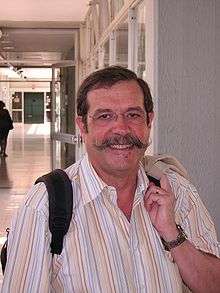Alain Aspect
| Alain Aspect | |
|---|---|
|
Alain Aspect in 2015, portrait via the Royal Society | |
| Born |
15 June 1947 Agen, France |
| Residence | France |
| Nationality | French |
| Fields | Physicist |
| Institutions |
Institut d'Optique École Polytechnique Centre national de la recherche scientifique |
| Alma mater | École Normale Supérieure de Cachan (E.N.S., 1965) |
| Known for | Bell test experiments |
| Notable awards |
|
|
Website www | |
Alain Aspect (French: [aspɛ]; born 15 June 1947) is a French physicist noted for his experimental work on quantum entanglement.[2][3][4]
Education
Aspect is a graduate of the École Normale Supérieure de Cachan (ENS Cachan). He passed the 'agrégation' in physics in 1969 and received his master's degree from Université d'Orsay. He then did his national service, teaching for three years in Cameroon.
In the early 1980s, while working on his PhD thesis[5] from the lesser academic rank of lecturer, he performed the elusive "Bell test experiments" that showed that Albert Einstein, Boris Podolsky and Nathan Rosen's reductio ad absurdum of quantum mechanics, namely that it implied 'ghostly action at a distance', did in fact appear to be realised when two particles were separated by an arbitrarily large distance (see EPR paradox). A correlation between their wave functions remained, as they were once part of the same wave-function that was not disturbed before one of the child particles was measured.
Aspect also received an Honorary Doctorate from Heriot-Watt University in 2008 [6]
Research
If quantum theory is correct, the determination of an axis direction for the polarization measurement of one photon, forcing the wave function to 'collapse' onto that axis, will influence the measurement of its twin. This influence occurs despite any experimenters not knowing which axes have been chosen by their distant colleagues, and at distances that disallow any communication between the two photons, even at the speed of light.
Aspect's experiments, following the first experiment of Stuart Freedman and John Clauser in 1972, were considered to provide further support to the thesis that Bell's inequalities are violated in its CHSH version, in particular by closing a form of the locality loophole. However, his results were not completely conclusive, since there were so-called loopholes that allowed for alternative explanations that comply with local realism. See local hidden variable theory.
Stated more simply, the experiment provides strong evidence that a quantum event at one location can affect an event at another location without any obvious mechanism for communication between the two locations. This has been called "spooky action at a distance" by Einstein (who doubted the physical reality of this effect). However, these experiments do not allow faster-than-light communication, as the events themselves appear to be inherently random.
After his works on Bell's inequalites, he turned toward studies of laser cooling of neutral atoms and is now mostly involved in Bose–Einstein condensates related experiments.

Aspect was deputy director of the French "grande école" SupOptique until 1994. He is a member of the French Academy of Sciences and French Academy of Technologies, and professor at the École Polytechnique. In 2005 he was awarded the gold medal of the Centre national de la recherche scientifique, where he is currently Research Director. The 2010 Wolf Prize in physics was awarded to Aspect, Anton Zeilinger and John Clauser. October 7, 2013, Aspect was awarded the Danish Niels Bohr International Gold Medal. In 2013 he was also awarded the Balzan Prize for Quantum Information Processing and Communication.

Awards and honors
Aspect was elected a Foreign Member of the Royal Society (ForMemRS) in 2015.[7] His certificate of election reads
| “ | For his fundamental experiments in quantum optics and atomic physics. Alain Aspect was the first to exclude subluminal communication between the measurement stations in experimental demonstrations that quantum mechanics invalidates separable hidden-variable theories and the first to demonstrate experimentally the wave–particle duality of single photons. He co-invented the technique of velocity-selective coherent population trapping, was the first to compare the Hanbury Brown-Twiss correlations of fermions and bosons under the same conditions, and the first to demonstrate Anderson localization in an ultra-cold atom system. His experiments illuminate fundamental aspects of the quantum-mechanical behaviour of single photons, photon pairs and atoms.[1] | ” |
References
- 1 2 "Certificate of Election: EC/2015/48: Aspect, Alain". London: The Royal Society. Archived from the original on 2015-09-16.
- ↑ Experimental Realization of Einstein-Podolsky-Rosen-Bohm Gedankenexperiment: A New Violation of Bell's Inequalities, A. Aspect, P. Grangier, and G. Roger, Physical Review Letters, Vol. 49, Iss. 2, pp. 91–94 (1982) doi:10.1103/PhysRevLett.49.91
- ↑ Experimental Test of Bell's Inequalities Using Time-Varying Analyzers, A. Aspect, J. Dalibard and G. Roger, Physical Review Letters, Vol. 49, Iss. 25, pp. 1804–1807 (1982) doi:10.1103/PhysRevLett.49.1804
- ↑ Aspect, Alain (2007). "Quantum mechanics: To be or not to be local". Nature. 446 (7138): 866–867. Bibcode:2007Natur.446..866A. doi:10.1038/446866a. ISSN 0028-0836. PMID 17443174.
- ↑ CV
- ↑ "Annual Review 2008: Principal's Review". www1.hw.ac.uk. Retrieved 2016-03-29.
- ↑ https://royalsociety.org/people/alain-aspect-11012/
External links
| Wikiquote has quotations related to: Alain Aspect |
- Aspect's homepage
- Atom Optics group, Laboratoire Charles Fabry, Institut d'Optique
- Biography at CNRS
- http://www.lcf.institutoptique.fr/Groupes-de-recherche/Optique-atomique/Membres/Membres-permanents/Alain-Aspect
- http://www.academie-sciences.fr/academie/membre/Aspect_Alain.htm
- Lévy Statistics and Laser Cooling: http://www.cambridge.org/us/knowledge/isbn/item1169242/?site_locale=en_US
- Speakable and Unspeakable in Quantum Mechanics: http://www.cambridge.org/us/knowledge/isbn/item1149699/?site_locale=en_US
- Introduction to Quantum Optics: http://www.cambridge.org/us/knowledge/isbn/item2712310/Introduction%20to%20Quantum%20Optics/?site_locale=en_US
- Alain Aspect International Balzan Prize Foundation
